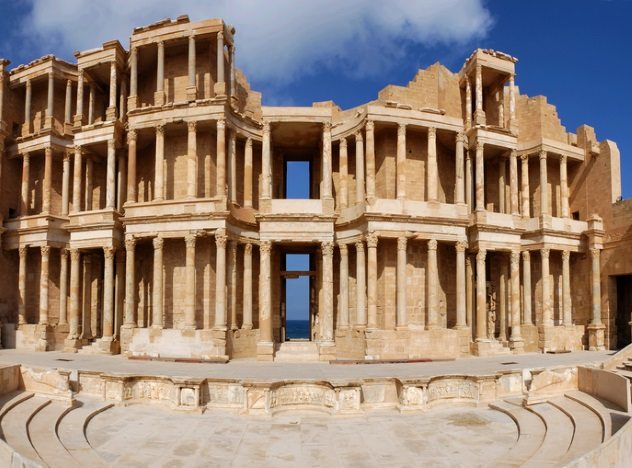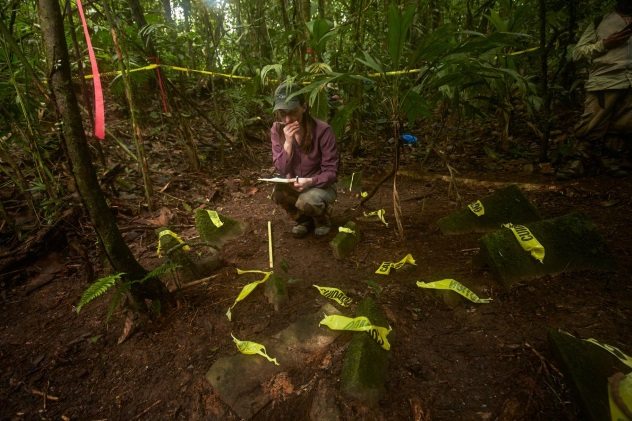 Weird Stuff
Weird Stuff  Weird Stuff
Weird Stuff  Our World
Our World 10 Archaeological Discoveries of 2025 That Refined History
 Weird Stuff
Weird Stuff 10 Fascinating Facts You Might Not Know About Snow
 Miscellaneous
Miscellaneous Top 10 Things Crypto Was Supposed to Change & What Actually Did
 History
History 10 Huge Historical Events That Happened on Christmas Eve
 Music
Music 10 Surprising Origin Stories of Your Favorite Holiday Songs
 History
History 10 Less Than Jolly Events That Occurred on December 25
 Weird Stuff
Weird Stuff 10 Funny Ways That Researchers Overthink Christmas
 Politics
Politics 10 Political Scandals That Sent Crowds Into the Streets
 Weird Stuff
Weird Stuff Ten Bizarre Facts About The Doge Meme
 Weird Stuff
Weird Stuff 10 Weird Things People Used to Do at New Year’s
 Our World
Our World 10 Archaeological Discoveries of 2025 That Refined History
 Weird Stuff
Weird Stuff 10 Fascinating Facts You Might Not Know About Snow
Who's Behind Listverse?

Jamie Frater
Head Editor
Jamie founded Listverse due to an insatiable desire to share fascinating, obscure, and bizarre facts. He has been a guest speaker on numerous national radio and television stations and is a five time published author.
More About Us Miscellaneous
Miscellaneous Top 10 Things Crypto Was Supposed to Change & What Actually Did
 History
History 10 Huge Historical Events That Happened on Christmas Eve
 Music
Music 10 Surprising Origin Stories of Your Favorite Holiday Songs
 History
History 10 Less Than Jolly Events That Occurred on December 25
 Weird Stuff
Weird Stuff 10 Funny Ways That Researchers Overthink Christmas
 Politics
Politics 10 Political Scandals That Sent Crowds Into the Streets
 Weird Stuff
Weird Stuff Ten Bizarre Facts About The Doge Meme
10 Legendary Lost Cities That Have Actually Been Found
We may never find the underwater grave of Atlantis, the golden streets of El Dorado, or the peaceful mountains of Shangri-La. By all rights, these places probably never really existed. They were just flights of our imaginations, thoughts of what wonders the world could hold.
But there are real places that are every bit as incredible as our fantasies. There are cities that, like Atlantis, were wiped clean off the face of the Earth. For hundreds of years, they lived on as nothing but stories, often ones that were so incredible that people doubted they ever really existed.
But these lost cities have been found. They weren’t just myths—they were actually out there, just waiting for us to uncover them. And if they’re real, it might just mean that there are no legends too spectacular to be true.
10 Helike: The Real-Life Atlantis

Atlantis wasn’t the only mythical Greek city that sank under the water. The city of Helike met the same fate, and it shares every bit of Atlantis’s mythic power.
According to Greek myths, Helike was destroyed by the wrath of the god Poseidon. The city’s residents had driven the Ionian tribe, who were loyal worshipers of the god of the sea, out of Helike. In his fury, Poseidon pulled the whole city under the water in a single night.
Helike was destroyed in 373 BC, and for centuries, it was thought to be nothing more than parable—until it was found. In the late 1980s, two archaeologists started a quest to track it down. It took them more than a decade of work, but they found it. Over the centuries, Helike had been buried under the Earth.[1] A mythic city was underneath their very feet.
The disaster that destroyed it, the team discovered, wasn’t exactly an act of Poseidon, but it would have felt like one. An earthquake liquefied the ground, turning the earth beneath the hapless Greeks’ feet into water as their whole city collapsed into an inland lagoon formed by the devastating tremor.
9 Dvaraka: The Home Of Krishna

To a Hindu, Dvaraka (sometimes spelled Dwarka) is as sacred as a city can be. It is the ancient home of Krishna, the supreme personality of the God Head, who lived on the Earth 5,000 years ago.
Dvaraka was built by the architect of the gods under Krishna’s own orders, who demanded a city made of crystal, silver, and emeralds. He also demanded that 16,108 palaces be made for his 16,108 queens. In the end, though, the city was destroyed in a massive battle between Krishna and King Salva, who annihilated it with blasts of energy.
It all sounds like the last thing you’d expect to have any truth in it—but when archaeologists started exploring the sea where Dvaraka was supposed to have been, they actually found the ruins of a city that fit the description.[2] It didn’t have 16,108 silver palaces, but it was a major ancient city with the same layout, and the rest fit as just a little bit of embellishment.
There’s reason to believe the real Dvaraka might have first been built 9,000 years ago, making it one of the oldest cities on Earth. At its peak, it was one of the busiest seaports in the world. Then, in the second millennium BC, it collapsed into the water, just like in the legend.
8 Great Zimbabwe: The Medieval Castle Of Africa

In the early 16th century, Portuguese explorers started reporting that they’d heard legends about a castle in Africa. In the land today known as Zimbabwe, the natives told them, was a stone fortress that towered over the trees. The locals called it “Symbaoe,” and even they didn’t know who had built it.
One explorer wrote home, “When, and by whom, these edifices were raised, as the people of the land are ignorant of the art of writing, there is no record, but they say they are the work of the devil, for in comparison with their power and knowledge it does not seem possible to them that they should be the work of man.”
For centuries, Europeans thought Symbaoe was just a superstitious story. Then, in the 19th century, they actually found it. There, in Zimbabwe, was a massive castle with stone walls more than 11 meters (36 ft) tall.[3]
The castle was made in AD 900 by an African civilization that has been lost to time—but they were incredibly connected. Inside the fortress, relics were found from all around the world, likely gathered by trading with other countries. There were Arab coins, Persian pottery, and even relics from the Chinese Ming dynasty.
Great Zimbabwe is more than just a castle. It’s proof that a lost African civilization, forgotten to history, had trade routes that connected all the way to China.
7 Xanadu: The Palace Of Kublai Khan

Marco Polo came back from China with some incredible descriptions of Kublai Khan’s empire. The most incredible of all, though, was Xanadu, the palace of the great khan.
Xanadu, Marco Polo said, was a marble palace surrounded by a massive, 26-kilometer-wide (16 mi) park filled with fountains, rivers, and wild animals. There, the khan kept 10,000 pure white horses in a golden palace guarded by dragons. It was, in short, a paradise unlike any on Earth.
The palace was destroyed by the Ming army in 1369, long before most Europeans got the chance to see it. As the centuries passed by, it slipped into legend. It was a place poets wrote about but was little more than the stuff of imagination.
Since then, though, the site of Kublai Khan’s palace has been uncovered, and we’ve found that Marco Polo wasn’t exaggerating. The khan’s home was twice as big as the White House, surrounded by a massive park that seems to have once held a wild menagerie of animals from around the world.[4]
There are ramps for horses in every part of it, and it even has the dragons Marco Polo described. They’re statues sitting atop of pillars that have been painted yellow—but they’re posed exactly as he said they were.
6 Sigiriya: The Eighth Wonder Of The World

In Sri Lanka, in the fifth century AD, King Kassapa built his palace atop a boulder that was 200 meters (650 ft) tall. According to the legends, it was one of the most incredible castles in the world. To get in, one had to walk up a large staircase that went through the mouth of a massive brick-and-plaster lion.[5]
Kassapa didn’t live in his castle for long. Shortly after it was completed, his brother Mogallana attacked. Kassapa’s army deserted him, terrified for their lives, and his wives leaped off the side of the boulder to their deaths. Sigiriya was conquered and left behind as a monument to the king’s excess. For a while, it became an outpost and, later, a Buddhist monastery, but soon, it was forgotten to time.
When European archaeologists started investigating the story, though, they found out that the castle was real. There really was a massive lion guarding the staircase, and one really had to walk through his mouth to get in.
Inside, it is even more incredible than the legends said. At one part, there is a gleaming white parapet that works a mirror, letting the bloated king stare at his own reflection as he walks through his palace.
UNESCO declared Sigiriya the eighth wonder of the world, and today, it’s a popular tourist destination. But for a long time, it was nothing more than the forgotten ruins of a deposed tyrant.
5 Leptis Magna: The Roman City Buried In Sand

A massive Roman city in Libya that was once a major trading hub for the empire was buried in a sandstorm.
The city is called Leptis Magna, and it was the place where the Roman emperor Septimus Severus was born. He turned it into a gigantic city and one of the most important parts of his empire, but when Rome started to fall, Leptis Magna fell with it. It was pillaged by raiders, destroyed by Arab invaders, left in ruins, and completely forgotten until it was buried under the drifting sands.[6]
Leptis Magna spent about 1,200 years buried under sand dunes until 19th-century archaeologists found it. Buried under the sand, the city was almost perfectly preserved. They didn’t just find a few broken pots there; they got to unearth and walk through a whole ancient Roman city.
Leptis Magna still has an amphitheater, baths, a basilica, and a circus, all preserved so incredibly by the sand that they look almost exactly how they would have when the city was in its prime. It’s like stepping into a time machine. It’s a lost, forgotten city—and because it was forgotten, it never had to change.
4 Vinland: The Viking Land Of Plenty

In AD 1073, a German cleric named Adam of Bremen spoke to the Danish king Sven Estridsson. The Vikings, Estridsson told him, had sailed across the Atlantic Ocean and found a distant land where everything grew boundlessly. “It is called Vinland,” the cleric reported, “because vines grow there of their own accord.”
He wasn’t the only one telling the story. The Vikings had been passing it down themselves, saying they’d fought with natives who lived there, whom they’d named the Skraelingar. The Skraelingar, they said, dressed in white clothes and lived in caves and holes. When they attacked, they carried long poles and charged, screaming out loud cries of war.
Vinland was thought to be a Viking myth for centuries, even after the Spanish reached the Americas. It took until the 1960s until we found out they were telling the truth. Then, at L’Anse aux Meadows in Newfoundland, Canada, archaeologists found the remains of a Viking settlement made in the 11th century—the Vinland they’d told so many stories about.[7]
3 Heracleion: The Drowned Egyptian City

Heracleion showed up in almost every Greek myth. It was the city where Heracles took his first steps into Africa. It was the place where Paris of Troy and his stolen bride Helen hid from Menelaus before the Trojan War. And we had no idea where it was.
As it turned out, there was a reason we couldn’t find one of Egypt’s most important ports: It was underwater. About 2,200 years ago, Heracleion was likely hit by an earthquake or a tsunami—and it drowned.
Divers swimming off the coast of Egypt stumbled upon it in the early 2000s. They found a strange rock under the water, and when they brought it up, they realized that it was a piece of an ancient statute. They dove back in to see what else was there. Soon, they’d found full statues, jewels, and even the drowned ruins of an ancient Egyptian temple.[8]
A massive part of the city was still intact. Divers were able to find huge steles put up as notices to visitors, warning them, in hieroglyphics, of Egyptian tax laws. They found statues of ancient Egyptian gods, still in their original form, with fish swimming around them. It was an entire lost city, pulled from the depths of the water and brought back to life.
2 La Ciudad Perdida: The Lost Colombian City

Around 1,300 years ago, an ancient people called the Tairona built an incredible city along the Sierra Nevada de Santa Marta mountainsides. It was put up at the top of the hills by the command of their god, who wanted them to live close to the stars.
People lived there for 700 to 800 years—until the Spanish conquistadors arrived. The Tairona never met them, but the diseases the Spaniards brought with them spread to the Tairona and wiped them out. The last people in the city died, it was left barren, and an entire civilization was forgotten for hundreds of years.
The city wasn’t discovered until the 1970s, when a group of bandits making their way through the jungle stumbled upon it by chance. By pure luck, they found an ancient, overgrown city full of gold jewelry and jade figures.[9]
They pocketed what they could find and sold it on the black market, where they came to the attention of archaeologists. Soon, the city known only as “The Lost City” was found, after nearly 500 years hidden in the jungle.
1 La Ciudad Blanca: The City Of The Monkey God

In his quest for gold, Hernan Cortes heard rumors that there was a city of great wealth hiding in the jungles of Honduras. It was called the White City by some and the City of the Monkey God by others, and it was promised to hold an incredible fortune.
Cortes never found it—but the legend lived on. Charles Lindbergh claimed he saw it flying over the country, and others spread rumors that they’d found it but, for whatever reason, couldn’t say where it was, and the city remained nothing more than a legend.
Archaeologists may have actually found it. A group followed the path described by one of the crazier people who claimed to have found the place, and to their surprise, they actually found a city where he said it would be. They found a pyramid in a rain forest, built by a culture that had vanished 1,000 years ago.[10] Inside, there were caches of stone sculptures and impressive architecture that, by the standards of their neighbors, would have been considered signs of incredible wealth and power.
Some people doubt whether this is really the city Cortes wrote about, but if nothing else, it’s evidence of a lost civilization of people who lived their entire lives out in the jungle, separated from life, and whose very existence had been all but forgotten until now.
Read more about real legends on 10 Historical Legends That Are Probably True and 10 Mythical Things that Actually Existed.








